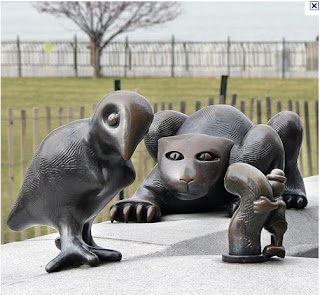
We piled into our 10 year old Volvo last night, picked up our friends the Gregory’s, and went off on our annual search for the Best Holiday Home Display. We’re tough critics. We’ve only awarded three perfect 10s in Rochester – one with a nearly life-sized Santa landing on the side yard in a helicopter and another with all the usual snowpeople, angels, and santas but also lighted palm trees, dancing dolphins and a garbage truck sized elephant. Obviously, tons of lights – all colors and some blinking – are basic requirements and music is always a nice touch.
This was our first nighttime excursion through the neighborhoods of our winter home here in North Carolina and I must tell you, it’s hard to get too excited about Christmas with temperatures still hovering around 60 and too many (ho-hum) displays of white lights on shrubs.
Then we found the open garage door at John Montalbano’s house.
From the driveway, you first notice the mid-range ear split buzz of model trains almost but not quite drowning out the Christmas music. Get closer….and closer….and THERE THEY ARE! Dozens of model trains race around tracks weaving through an idealist version of a village Christmas. Houses and storefronts glow. Nearly every tree is decked out with glittering lights while tiny people ice skate on ponds, sled down hills or wander the sidewalks. 0ne small boy perpetually makes snow angels. In the outdoor drive-in movie theater “White Christmas” - the real thing! - is playing to a few parked sedans.
John began this extravaganza seven years ago to cheer up his neighbor Grace. Grace is a double breast cancer survivor (The village includes “Grace Bridge. Really! Could her name be any more perfect for this entire concept?) A large bottle sits beside the garage door to accept donations to a Charlotte cancer research center.
John says he collects display parts mostly from garage sales and flea markets all year – everything carefully stored in plastic boxes until the first of November when he begins construction. His goal is to finish the installation by Thanksgiving when he hosts an unveiling party for his immediate neighbors. From then through December, the garage doors are open every evening for gawkers – any age – and John stands by to answer questions.
We clapped for John, for the trains, for the generosity of the holidays but we only gave John a score of 9.5. After all, there wasn’t an elephant in sight.
(For more info about Trains for a Cure, go to his web site: john@trainsforacure.org.)








































